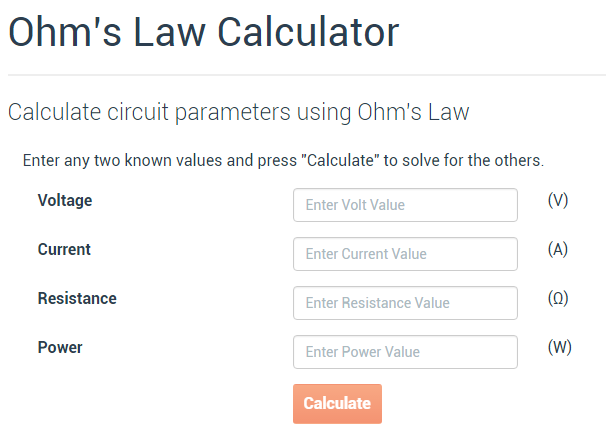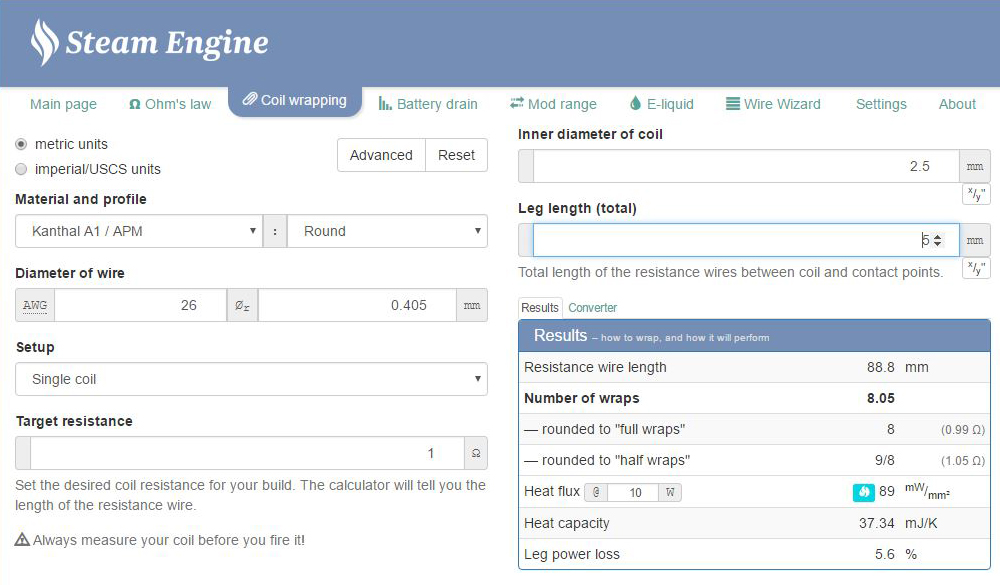b7u3angel;13928160 said:
Here is possibly a simpler explanation of Ohm's Law as it applies to vaping. Ohm's Law Explained for Vapors
I would suggest never to blindly trust a salesman's or a buddy's advice concerning coil resistance and batteries. I've seen and heard too many misinformed people. The fact is it is simple and easy to figure this out yourself. That is the purpose of this article.

- Know the true amp limit of the battery you have
- Know the amp draw of your coil.
This is where Ohm's Law and using an Ohm's Law calculator comes into play. If you come away with anything after reading this article, this is it.
(*NOTE: REGULATED MODS use a different formula than mechanical mods -- Watts Law.)
Finding Your Battery's Amp Limit
To find the amp limit of your battery, you'll need to do a little research. Find the "continuous discharge rate" or "CDR" of the battery.
Look on the manufacturer's website for the battery's specifications. Or look on a supplier's website. With some companies, you can trust the product specifications (ie Lg, Panasonic, Samsung, and Sony). WARNING: Some battery suppliers publish "word of mouth" specifications which may be untrue. Don't trust just one source of information.
Chinese aftermarket batteries such as Efest, AWT, Imren, MXJO, et al, you CAN'T trust their amp specs because they intentionally exaggerate their battery's specs to get you to buy their battery over their competitors. Are You Using a Rewrap (Rebranded or Aftermarket) Battery?
The BEST solution is find the documentation of independent bench test results of brand and model number of batteries to find the true amp rating. Battery Mooch tests batteries for the vaping community.
Battery Mooch's List of Battery Tests
To simplify things for you, below I have the top 18650 batteries recommended by Mooch. If your battery is not shown below, chances are great that its test results did not meet the manufacturer's advertised specification.
Mooch's Recommended 18650-size Batteries
Mooch's Recommended 18650-size Batteries
Samsung 18650 30Q, 3000 mah 15 amp CDR
 *
*
Sony 18659VTC6 3000mAh 15 amp CDR
 *
*
LG 18650HG2 3000mah 20 amp CDR

Sony 18650VTC5, 2600 mah 20 amp CDR

LG 18650HE4 2500 mah 20 amp CDR

Samsung 18650-25R, 2500 mah 20 amp CDR

Sanyo UR18650 NSX, 2500 mah 20 amp CDR

Sony 18650VTC4, 2100 mah 23 amp CDR

Sony 18650VTC5A, 2500 mah 25 amp CDR

Samsung 18650-24S, 2500 mah 25 amp CDR

Molicel 18650-P26A, 2600 mah 25 amp CDR

LG 18650 HD4 2100 mah 25 amp CDR

LG 18650 HD2 2000 mah 25 amp CDR

LG18650HB6 1500mah 30 amp CDR

LG18650HB2 1500mAh 30 amp CDR

LG18650HB4 1500mAh 30 amp CDR

Sony 18650VTC3 1500mAh 30 amp CDR

Samsung 18650-20S 2000mah 30 amp CDR

* Manufacturer's CDR is 15A. The Samsung 30Q datasheet (Section 7.9) mentions operation at 20A. Operation at that level can be done as long as we don’t let the battery get above 75°C, its maximum rated operating temperature. This holds true for the Sony VTC6 battery as well. These are not a high performance “power” cell, designed for high current. They are a high capacity “energy” cell designed for low to moderate power levels and long running time. At higher current levels the voltage sag and power loss in the cell are huge. Do not exceed 20A.
Mooch's Recommended 21700-size Batteries
Sony 18659VTC6 3000mAh 15 amp CDR

LG 18650HG2 3000mah 20 amp CDR

Sony 18650VTC5, 2600 mah 20 amp CDR

LG 18650HE4 2500 mah 20 amp CDR

Samsung 18650-25R, 2500 mah 20 amp CDR

Sanyo UR18650 NSX, 2500 mah 20 amp CDR

Sony 18650VTC4, 2100 mah 23 amp CDR

Sony 18650VTC5A, 2500 mah 25 amp CDR

Samsung 18650-24S, 2500 mah 25 amp CDR

Molicel 18650-P26A, 2600 mah 25 amp CDR

LG 18650 HD4 2100 mah 25 amp CDR

LG 18650 HD2 2000 mah 25 amp CDR

LG18650HB6 1500mah 30 amp CDR

LG18650HB2 1500mAh 30 amp CDR

LG18650HB4 1500mAh 30 amp CDR

Sony 18650VTC3 1500mAh 30 amp CDR

Samsung 18650-20S 2000mah 30 amp CDR

* Manufacturer's CDR is 15A. The Samsung 30Q datasheet (Section 7.9) mentions operation at 20A. Operation at that level can be done as long as we don’t let the battery get above 75°C, its maximum rated operating temperature. This holds true for the Sony VTC6 battery as well. These are not a high performance “power” cell, designed for high current. They are a high capacity “energy” cell designed for low to moderate power levels and long running time. At higher current levels the voltage sag and power loss in the cell are huge. Do not exceed 20A.
Samsung 21700 40T 4000mAh 25 amp CDR

Molicel 21700 4000mAh 30 amp CDR
 (best all around 21700, a bit wider in diameter than other 21700's)
(best all around 21700, a bit wider in diameter than other 21700's)
Samsung 21700 30T 3000 mah 35 amp CDR
 (highest amp rating for a 2100)
(highest amp rating for a 2100)
Samsung 21700 50E2 5000 mah 10 amp CDR
 (highest capacity 21700, but only 10A, must have "2" on third line of battery)
(highest capacity 21700, but only 10A, must have "2" on third line of battery)

Molicel 21700 4000mAh 30 amp CDR

Samsung 21700 30T 3000 mah 35 amp CDR

Samsung 21700 50E2 5000 mah 10 amp CDR

Mooch's Recommended 20700-size Batteries
Sanyo 20700 NCR2070C 3500 mah 30 amp CDR

Sanyo 20700 20700B 4000mAh 15 amp CDR
 (best if used under 10A and under 30 watts)
(best if used under 10A and under 30 watts)
Molicel INR20700A 2800mAh 30 amp CDR


Sanyo 20700 20700B 4000mAh 15 amp CDR

Molicel INR20700A 2800mAh 30 amp CDR

When you push the button on a mech mod, you complete a DC circuit. The battery in your mod doesn't know or doesn't care what the resistance of the coil wire is. All the battery knows is the circuit is complete and that it has to obey Ohms Law. It will attempt to fire the coil whether it has enough current or not. If it doesn't have enough current, it will over-heat and possibly vent or go into thermal runaway. Not a good thing. (See pics below)
Ohms Law says that the amount of amps will be equal to the voltage divided by the resistance.
The more resistance you have with the coil, the higher the ohms will be and the less amps from the battery are needed. The lower the resistance of the coil, the lower the ohm will be and higher amps will be required to fire the coil. Note below, the lower the ohm, the higher the amp draw.
1.0 ohm = 4.2 amp draw
0.9 ohm = 4.6 amp draw
0.8 ohm = 5.2 amp draw
0.7 ohms = 6 amp draw
0.6 ohms = 7 amp draw
0.5 ohms = 8.4 amp draw
0.4 ohms = 10.5 amp draw
0.3 ohms = 14.0 amp draw
0.2 ohms = 21.0 amp draw
0.15 ohms = 28 amp draw
0.1 ohms = 42.0 amp draw
0.0 ohms = dead short = battery goes into thermal runaway
0.9 ohm = 4.6 amp draw
0.8 ohm = 5.2 amp draw
0.7 ohms = 6 amp draw
0.6 ohms = 7 amp draw
0.5 ohms = 8.4 amp draw
0.4 ohms = 10.5 amp draw
0.3 ohms = 14.0 amp draw
0.2 ohms = 21.0 amp draw
0.15 ohms = 28 amp draw
0.1 ohms = 42.0 amp draw
0.0 ohms = dead short = battery goes into thermal runaway
Bottom line: never exceed the battery's CDR. To do so is abusing the battery and dangerous.
Using an Ohm's Law Calculator
Finding the "Amp Draw" of a Coil
To find out what current (amps) the coil will pull from the battery in a mechanical mod (known as the "amp draw"), you use an online Ohms Law Calculator. This is a remarkable tool. You insert 2 known values and it comes up with the 2 unknown values. For our purposes here, the Power value in watts is irrelevant for a mech mod.


When using dual coils: Using dual coils halves the resistance. Example: Two 0.3 ohm coils will have a total resistance of 0.15 ohms.
First scenario.
We know from our research what the CDR (amp limit) of our batteries are. We insert that number (for example 20 amps) into the Current section. We also know that our fully charged battery will provide 4.2 volts and insert 4.2 into the Voltage section. When we click Calculate, the lowest resistance of the coil that can be used will be revealed in the Resistance section. 0.21 ohms is the "amp draw" and the absolute lowest resistance that we can use with that 20 amp battery.
Voltage: 4.2 volts
Current: 20 amps
Resistance: 0.21 ohms
Current: 20 amps
Resistance: 0.21 ohms
So if you battery is rated at 20 amps continuous discharge, you should not build anything that requires the battery to provide more than about 18 Amps. You should always leave a little "headroom" or safety margin.
Second scenario.
We measured our coil with an ohm meter and found that its resistance is 0.1 ohm. We want to know if our 30 amp battery can safely be used to fire that coil. We know the coil resistance (0.1 ohm) and we know the battery voltage (4.2 volts), so we insert those two values respectively into the calculator. Click Calculate.
The value that shows up in the Current window is the amps the coil will draw (the "amp draw" ) -- 42 amps! OOOOPS! This resistance is TOO LOW to fire safely with a 30 amp battery because the coil's amp draw is 12 amps over the amp limit of the battery (30A continuous discharge rate). We will need to use a coil with a higher resistance.
Voltage: 4.2 volts
Current: 42 amp draw
Resistance: 0.1 ohm
Current: 42 amp draw
Resistance: 0.1 ohm

If we increase the resistance just a little to 0.14 ohms and repeat the calculations, the amp draw and amp limit match up equally (amp draw and amp limit are the same value). The difference of 0.04 ohms is huge when comparing the amp draw of the two coils.
Voltage: 4.2 volts
Current: 30 amp draw
Resistance: 0.14 ohms
Current: 30 amp draw
Resistance: 0.14 ohms
Please keep in mind that the accuracy of a cheap $10 ohm reader may leave much to be desired, expecially when we are using resistances in the tenths and hundreths of an ohm. This is why it is prudent to have a margin of safety by using a coil resistance with a little headroom in mind.
To repeat, never use a coil that will draw more current from the battery than it has to give. Never use a battery that can not safely supply the amps required to fire a coil. It's really that simple.
How Can I Build a Coil with a Safe Resistance for My Battery?
Learn to use a Coil Wrapping Calculator like the one at Steam Engine.

Basic Guide to Vaping Wire
Types of Wire, Gauges of Wire, and more
If just starting out making your own coils, I suggest studying the above tutorial video first. Then experiment: start putting data into the online Steam Engine calculator and see what results you end up with. The calculator uses a drop down menu. As you add more or change data, the number of wraps you need will be revealed in the results box.
Get comfortable with the format. Play around and use different data to see how that affects the final results. You're not going to cause any harm at this point.
You probably should start with 26 or 28 gauge kanthal or stainless steel wire. Set a target resistance; say 0.6 ohm. Fill in the other data into the calculator such as single or dual coil, your target coil resistance, and inner coil diameter.
I like an inner diameter of 3 mm because a larger diameter coil is easier to wick, but you could go with a more narrow diameter to get more wraps per coil if that is your goal. Smaller diameter will increase the number of wraps; larger diameter will decrease the number of wraps. Don't bother putting in the leg length, the calculator will simply set a default value for you.
Remember if making dual coils, the overall resistance is halved. For example: two 1.2 ohm coils delivers a total resistance of 0.6 ohm, not 2.4 ohms. More wraps increases resistance, less wraps decreases resistance.
A good ballpark target to shoot for is 6 - 8 wraps for an ideal coil. It doesn't matter if you compress your wraps or leave them spaced apart, its personal preference. I personally like compressing them as they seem to be more sturdy with repeated wicking.
And remember, ALWAYS measure the resistance of your completed coil on an ohm meter; don't blindly trust the calculations from a calculator or that a friend's recommendations will be correct (or safe) -- there is too much chance for human error. Be safe.
Then get your tools and supplies.
Tools:
- Resistance wire – kanthal, stainless steel, nickel, nichrome, etc.
- Flush wire cutters – wire cutters that can cut close in small spaces
- Tweezers – preferably ceramic tipped, to pinch your coils while pulsing
- Needle nosed pliers - used to pull/straighten your wire
- Scissors - to trim you cotton wick
- An ohm reader - or a mod that accurately measures coil resistance
- Small metal rods – a precision screwdriver set, or coiling tool
- Organic cotton – or whichever wicking material you prefer
- A coil jig – it can make your life a little easier than the precision screwdrivers
- A second vape – to vape on while you’re building those coils, silly







You don't need a coil jig set, but you will need at least a precision screwdriver set that has a variety of stem diameters to wrap your coils around and their stem diameters labeled on each screwdriver. You'll need a wire cutter or nail clipper to cut wire. You'll need an ohm meter to measure the resistance of your finished coil.
I would suggest either 26 or 28 gauge kanthal wire to start out. Don't try to start out fancy by trying to make a fancy exotic coil like a Clapton. Keep it simple, stupid (KISS).



You'll need either organic cotton balls, cellucotton (Rayon), or one of the commercially available wick materials like Cotton Bacon sold at vape shops or online vendors.
Grimm Green does a nice coil building tutorial for beginners:
FOR SAFETY'S SAKE: KNOW THE DIFFERENCE BETWEEN UNREGULATED SERIES AND PARALLEL TWO-BATTERY BOX MODS

Please click the above link (title) to learn the difference between series and parallel dual battery mech mods.
In Review...
When you build your coil and fire it on your mod, it will "draw" a specific amount of current (amps) from the battery. That amp draw must not be more than the total amps of the battery, or very bad things could happen.
Know your batteries and know your gear. Don't become a blip on the evening news.




hand and facial trauma from vented battery and mod explosion
Never fire a coil without first confirming the ohm resistance on an ohm reader or multimeter. You can't just rely on a coil wrapping calculator or somebody's recommendations, there's too much chance for human error. The smallest error can be catastrophic. Even seasoned veterans always check the resistance of their coils on a meter to make sure they are safe.
Everyone is free to set their own parameters, and I can only say what mine are.
I try to never exceed 50% of the CDR (continuous discharge rating) of a fully charged battery (4.2v). So with a 20A batteries, that would be 10A. The above Ohm's Law Calculator tells me that a .4 ohm build is as low as I would want to use.
The reason that I place a 50% limit is because as a battery ages the mAh of the battery degrades, as the mAh degrades so does the batteries c rating (amp limit). So down the road, your 20A battery may only be a 10A battery.
Sorry for the graphic photos above, but I believe its important to get the point across that you should not mess with Ohm's Law when it comes to batteries. The above pics are extreme examples. The batteries we have can be quite safe if you use the correct batteries and do not abuse them beyond their recommended amp limit. Most battery incidents result from user error or wrong calculations, or ignoring safe battery practices.
A battery venting in thermal runaway will release extremely hot gas, toxic chemicals, and possibly flames. Once this chemical reaction begins, there is no stopping it. The gas can build up inside a mod, and if there is inadequate venting the mod becomes a little pipe bomb.

Man Severely Injured After E-Cigarette Explodes
Periodically recheck your build's resistance to insure it doesn't unknowingly fall below your target resistance. Also know there are two amp rating specs: Continuous and pulse (burst) discharge rating. Unless the advertisement specifically states which spec they are using, there is no way to know which one is listed.
I prefer using the continuous discharge rating over the pulse discharge rating. CDR is the industry standard. Pulse ratings are always higher than the continuous, and are not as reliable as the continuous rating.
Any “max” or “pulse” rating is useless unless we know the length of the pulse, the time between the pulses, and the criteria used to set the rating (Voltage sag? Temperature? Run time? A combination of those?). Without knowing this, and all companies using the same pulse lengths, rest times, and criteria, we can’t use the max/pulse ratings for comparing any batteries. They are useless.


